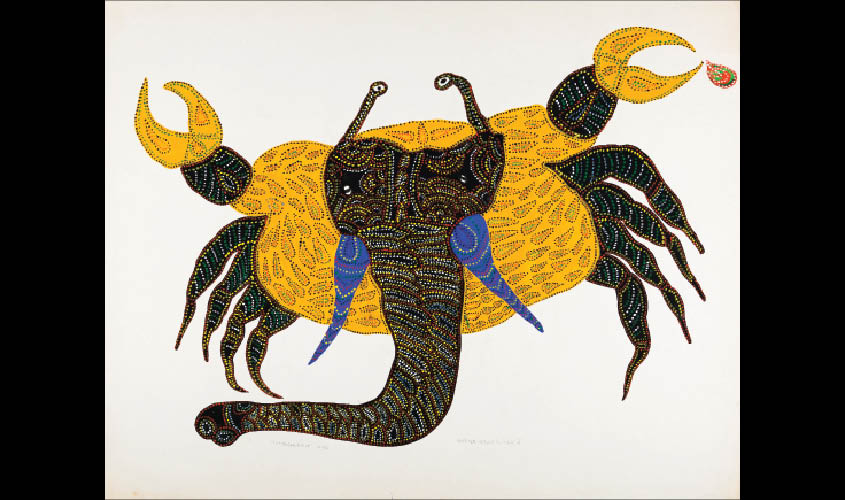Artist Jangarh Singh Shyam was only 40 when he reportedly committed suicide in 2001. A new retrospective of his work is now on view at the Kiran Nadar Museum of Art in Delhi, celebrating this short but remarkable life, writes Bhumika Popli.
A new retrospective of the late Gond artist Jangarh Singh Shyam, entitled A Conjuror’s Archive, is now on view at Delhi’s Kiran Nadar Museum of Art. The show enriches you, but also leaves you with a sinking feeling. It reminds you of the artist’s death in 2001 in Japan, reportedly a suicide. He was 40.
The last letters he wrote to his wife, Nankushiya, and to his mother, Adharabai, a few days before his death, give us a sense of how distressed he was in Japan. The translated letters, along with his paintings,
are on display at the Delhi show, and are also included in a book of the same title as that of the exhibition, published by the Museum of Art & Photography. A few of the excerpts read:
“Nankushiya, perhaps they will not let me return till July or August because they have given me large works [to complete] and have also put up anexhibition.”
“I am trying to finish the work—let’s see if I can manage. … [P]erhaps because I could not come here the previous year, they are upset with me.”
“I am working continuously, will try to finish, let’s see till when it will be done.”
“They are saying that I can go by 27 July but I have no trust in when they will relieve me.”
The next report which came from the Far East was of his unnatural death.

Jangarh’s untimely death created unrest in the art community and many top artists campaigned for a probe in the matter. “In the last letter written from Japan just three days before his death, he had sought my intervention in getting him sent back home from Japan,” writes Dr Jyotindra Jain, a key authority on folk and tribal arts, in his book on Jangarh. “Unfortunately, the letter arrived in Bhopal only after he had ended his life. To this day, the episode continues to haunt me and this is what gave the impulse for writing this book as a tribute to him,”
A Conjuror’s Archive pays homage to rich artistic imagination of Jangarh and his 20-year career in the arts. As you step closer to view his artworks on display, you are pulled into his imaginary world that combines a number of mythological narratives. You see an elephant-headed crab, a serpent holding the earth on its hood and many other such figures, from fables and creation myths. His world is layered with rich colours and dotted patterns. His paintings evoke a sense of awe and you wonder whether such a world exists somewhere.

Jangarh was truly a prodigy. He was making art since childhood and decorated the walls of his hut with paintings. His images have the capacity to pull the viewer into the art, because he himself was completely immersed in his works. He once said, “The first time I dipped my brush in bright poster colours in Bhopal, tremors went through my body.” This was the time he joined Bharat Bhavan at the invitation of his mentor Swaminathan.
Jangarh created a number of artworks at Bhopal’s Bharat Bhavan, drawing fish, birds, deities on paper in his trademark style of dotted patterns. Bharat Bhavan added substantially to his growth, but he suffered much mental agony for his fame. He started working as an attendant at this place. Jain writes, “Jangarh once told me that he was often abused by some of the artists at Bharat Bhavan. He said that when he was initially appointed as an attendant at Bharat Bhavan, he was rudely asked by some of his modern art colleagues to serve them tea or clear away empty cups and plates, often with a sarcastic comment that ‘you have now become a big artist’.”
As Swaminathan wrote about Jangarh, “One thing readily noticeable in all of them is their conceptual character: they are not naturalistically rendered. The deities become real by the truth of imagination.” “…[t]here is no doubt that he is an exception and herein lies our point: he is giving pictorial form to many of the Pardhan Gond deities… [I]t is the individual artist who gives visual, tactile expression to commonly held beliefs and it is only then that such expressions become communal property.”

His style came to be known as “Jangarh Kalam” and his oeuvre took inspiration from both the urban and rural surroundings. In his short life, Jangarh also created spectacular pen-and-ink drawings and contributed greatly with his rich murals to Bhopal’s Vidhan Bhavan. The artist was also interested in theatre and music. He used to sing and play the flute.
One of his paintings is entitled Young Boy Playing the Flute in the Forest. Jain reads this as a self-portrait where the artist has depicted himself as Krishna among the grazing cows and forest scenery. According to Jain, once Jangarh had mentioned to him that as a teenager
Jangarh was situated in his roots but at the same time wanted to explore his creative strengths. He found his art in the myths and fables, animals and birds and stories of his childhood, which remained with him till the very end. He was trying to return to these in his final days, but, as Jain writes, “he was trapped in crossing”.
‘A Conjuror’s Archive’ by Dr Jyotindra Jain is published by the Museum of Art & Photography, and is available for Rs 1950; the exhibition, curated by Dr Jyotindra Jain and Roobina Karode, is on view till 12 January 2019

